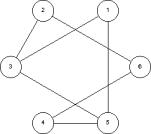
See the assignment turn-in page (last modified on 18 January 2006) for instructions on turning in your assignment.

Computer A communicates to computer B by waiting until an empty slot passes A's network interface on the bus moving in the direction of B. When A detects an empty slot it writes a packet into the slot. The packet contains B's address, which is recognized by B's network interface as the slot passes; the packet is removed from the slot, emptying the slot. B can then communicate with A by repeating the process on the opposite bus.
A DQDB network works best when packets make short trips on the busses. This occurs when computers that usually communicate are close together in the network. This can be modeled with an undirected graph and the idea of order distances.
The vertices of a graph G represent computers on the same DQDB network. An undirected edge between two nodes indicate computers that communicate with each other frequently.

The graph vertices can be arranged in a linear order to represent the computer's ordering on the network.

The order distance of a vertex v in such an arrangement is the largest number of nodes between v and any of v's neighbors. Node 3 in the previous image has order distance 1, as does node 4. The order distance of G is the largest order distance of all the vertices in G. The graph in the previous image has order distance 3, the order distance of the vertices 1 and 6.
for 0 ≤ i. For example, the graph given in the Background Section would be specified by the inputv n1 n1 ... ni
1 3 5 2 3 6 3 2 1 5 4 5 6 5 4 1 3 6 2 4
assuming the original graph had n vertices.d v1 v1 ... vn
gen-graph in the assignment directory /export/home/class/CS-503/a7
writes to std-out a description of an undirected graph in the format
expected by your program.
| This page last modified on 27 April 2006. |